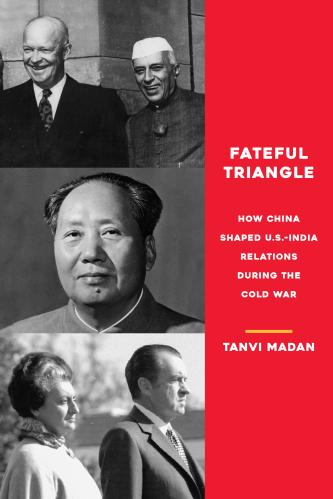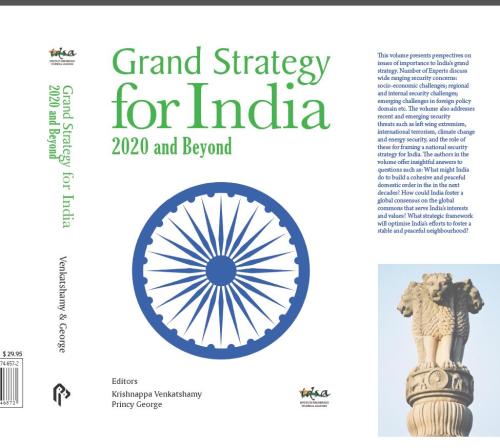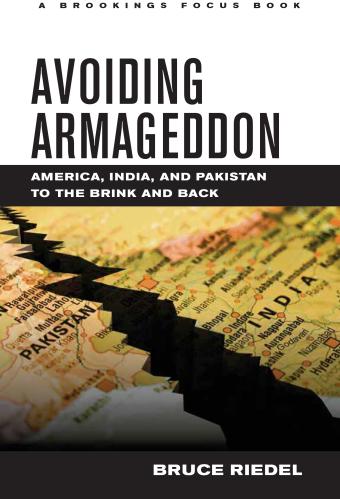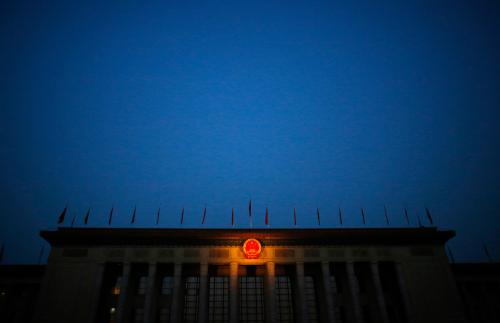Executive summary
 While their shared democratic nature has not been the only driver, it has certainly contributed directly and indirectly to the development of the U.S.-India partnership over the last two decades. Democracy, in various ways, has also been a realm of cooperation between the two countries in the past. It could be in the future as well, with the two democracies working together to ensure (1) democratic resilience in the Indo-Pacific region and (2) the resilience of the rules-based international order. To what extent they will be able to do so will depend on whether they can take advantage of certain opportunities and how they deal with certain challenges at home and abroad. And, as the role of democracy in the Biden administration’s foreign policy agenda is debated, both the opportunities and obstacles of this aspect of the relationship are worth considering.
While their shared democratic nature has not been the only driver, it has certainly contributed directly and indirectly to the development of the U.S.-India partnership over the last two decades. Democracy, in various ways, has also been a realm of cooperation between the two countries in the past. It could be in the future as well, with the two democracies working together to ensure (1) democratic resilience in the Indo-Pacific region and (2) the resilience of the rules-based international order. To what extent they will be able to do so will depend on whether they can take advantage of certain opportunities and how they deal with certain challenges at home and abroad. And, as the role of democracy in the Biden administration’s foreign policy agenda is debated, both the opportunities and obstacles of this aspect of the relationship are worth considering.
Introduction
India and the United States have often seen themselves as, if not argued that they are, exceptional. These assertions have been based in part on their status as pluralistic and powerful democracies. In many ways, it also fuels the expectations that they have for each other — sometimes higher than they have for other countries. It is also common for American and Indian officials to highlight this aspect of the U.S.-India relationship, asserting that it involves the oldest and largest democracies in the world — a phrasing so common that it has become a cliché.
While their shared democratic nature has not been the only driver, it has certainly contributed directly and indirectly to the development of the U.S.-India partnership over the last two decades. Democracy, in various ways, has also been a realm of cooperation between the two countries in the past. It could be in the future as well, but to what extent will depend on how they deal with certain challenges. And, as the role of democracy in the Biden administration’s foreign policy agenda and the idea of a global “Summit for Democracy” are debated and developed, both the opportunities and obstacles of this aspect of the relationship are worth considering.
The democracy dividend
There are at least five key pillars of the U.S.-India partnership: defense and security; economic; global cooperation; people-to-people ties; and shared values. This has created a wide and diverse set of constituencies for the relationship, including in different sectors and parts of the two democracies. It has also ensured cross-partisan support for U.S.-India ties in both countries. And all this has made the relationship more resilient and sustainable.
Democracy has contributed to the countries’ perception of each other as “natural” or “like-minded” partners, and even as role models — especially for countries and peoples seeking to balance democracy, diversity, and development.
Democracy has been a key element of the “values” pillar, which has also included a belief in pluralism and the rule of law. It has contributed to the countries’ perception of each other as “natural” or “like-minded” partners, and even as role models — especially for countries and peoples seeking to balance democracy, diversity, and development. For instance, then-Vice President Joe Biden noted in 2013 that “the message that [India’s] democracy sends to people everywhere in the world… is: No nation need choose between development and freedom. They are not inconsistent.”
Democracy has also been a force multiplier, bolstering the other pillars of the relationship. Take the strategic pillar. The last few American administrations have seen India as a geopolitical counterbalance, an economic alternative, and a democratic contrast to China that can demonstrate that development and democracy are not mutually exclusive. This view, in turn, has paved the way for the belief that India’s rise is in American interest and worth supporting, for growing defense and security cooperation, and for administrations making the case for exceptions for India (e.g., the civil nuclear deal). Indian policymakers, in turn, have pointed to their country’s democratic nature as grounds for such exceptions and a reason for its trustworthiness both in the U.S. and globally.
Turning to the economic pillar, which includes trade, investment, energy, immigration, and technology ties, one can quibble over how “free” the two countries are, but the fact that they are relatively open economies and societies with thriving private sectors and entrepreneurs, the prevalence of the rule of law, and legal systems that have roots in English common law have facilitated economic engagement and the exchange of goods, services, capital, ideas and people. Indian Prime Minister Narendra Modi has even made the case to investors that democratic and “law-abiding” India offers reliability and stability and suggested that American corporates should invest in “democratic engines” of growth.
The global cooperation pillar has included India-U.S. collaboration in and on multilateral organizations and groupings, and on global issues like climate change and public health. This, too, has benefited from the democracy element. The U.S. has perceived India as a different power than, say, China, in no small part because it is seen as a democracy, and consequently supported it in organizations such as the Nuclear Suppliers Group and, more recently, the United Nations Security Council (UNSC). And Delhi has made the case for a larger role on the world stage partly on that basis. Moreover, as Modi outlined in his 2016 speech to the U.S. Congress, the two democracies have cooperated and can do so on the principles of “cooperation not dominance; connectivity not isolation; respect for global commons; inclusive not exclusive mechanisms; and above all adherence to international rules and norms.”
Finally, people-to-people ties have benefited from the shared values pillar, which has facilitated the movement of people, knowledge production, cultural connections, and civil society interaction among other things.
Undoubtedly, the democratic nature of both the United States and India — with the sausage- or samosa-making visible in public — has also made it tougher (and slower) sometimes to cooperate in all these realms. But once the countries have worked through these differences, the outcomes have also tended to be more sustainable. Indeed, over the past two decades, U.S.-India relations have followed a steady (though non-linear) trend of broadening and deepening.
Cooperation: Looking back and moving forward
When discussing Delhi and Washington’s democracy agendas, the focus has often been on their differences. American observers have lamented that India has not supported democratization or U.S. democracy promotion efforts more actively. Indian observers have bemoaned both American interventionism on grounds of democracy promotion and U.S. support for various authoritarian regimes. At times, Americans see India as too much of a sovereignty hawk, while Indians see the U.S. as too ready to comment on other countries’ regimes and internal affairs. There are also divergences between the two countries on issues like freedom of speech, the right balance between national security and civil liberties, and how to deal with non-democratic countries. These are differences that could reemerge if and as the agenda and invitation list for a Summit for Democracy develops.
However, this narrative and focus on divergences can overlook past cooperation in this realm. For instance, arguably, one of the most successful instances of U.S. democracy promotion was in India. At a critical moment in democratic India’s early history, Indian leaders, led by Jawaharlal Nehru, were concerned about their ability to “deliver the goods” to their citizens. They were particularly anxious that if neighboring communist China succeeded in doing so while they didn’t, Indians would call for a different system of government than democracy. At this crucial juncture, American administrations poured billions of dollars in economic assistance into India (and later some military assistance) on the explicit ground that it was important to the “free world” for a democratic India to survive, if not thrive — particularly in the face of what was being seen as a “fateful race” between this fledgling Asian democracy and a Soviet-backed communist Chinese regime.
More recently, there have been efforts by the two countries to cooperate with each other and with fellow democracies. These include a National Endowment for Democracy-funded World Movement for Democracy conference in Delhi in 1999, cooperation to establish the Community of Democracies in 2000, efforts in 2004 to set up a United Nations Democracy Caucus, the 2005 launch of a U.S.-India Global Democracy Initiative that put forth democracy as a universal aspiration and pledged assistance to countries seeking to become more open and democratic, and the U.S. and India’s coordinated contributions and joint fundraising for the United Nations Democracy Fund. They have also cooperated to support the democratic government in Afghanistan and the democratic process in the Maldives. And, more broadly, their governments and civil societies have helped establish and strengthen electoral systems, provided legal and technical assistance and training, and supported civil society in democracies — sometimes in parallel, sometimes in coordination.
Beyond this, in the future, the two democracies could work together to ensure (1) democratic resilience in the Indo-Pacific region and (2) the resilience of the rules-based international order. The first would entail ensuring that existing democracies — including their own — are not weakened, and that even non-democracies retain their ability to make strategic and economic choices. Across the region Delhi and Washington — and their like-minded partners — have different comparative advantages (and weaknesses). They can give assistance where required, work jointly or in parallel to build democratic, electoral and/or civil society capacity, and provide economic and other alternatives. They can strengthen countries’ ability to assess, resist and counter external coercion and interference. And they can try to avoid working at cross-purposes, while recognizing that their perspectives and interests will sometimes be different or even conflict.
India and the U.S. can also cooperate to ensure the resilience of the rules-based international order. One aspect of this will be defensive i.e., ensuring that rules, norms, and laws are followed, showing solidarity for countries targeted by coercion or threats, and blunting attempts to weaken standards and/or misuse institutions. The other aspect of this will be going on offense with a positive agenda: proposing and supporting better, more transparent standards, striving to follow their own standards and principles, and ensuring the international order is responsive to countries’ needs and the crucial issues of the day.
This cooperation can be bilateral, but in what is likely to be an era of flexible multilateralism, it can also be via different coalitions. One such existing coalition is the Quad, while others proposed include a G-7+3, a D-10 (for 5G and artificial intelligence), and a T-12 (of techno-democracies). It can also be in international institutions. There has already been some cooperation among like-minded countries, including India and the U.S., at the World Health Organization (WHO), the World Intellectual Property Organization and the U.N. With India as chair of the WHO executive board for the next few months, the G-20 chair in 2023, and a member of the UNSC for the next two years, there could be more scope for such collaboration.
While much of the existing cooperation and proposals involve democracies, India and the U.S. will also have to find ways to include non-democracies that are nonetheless like-minded on certain issues. There will be also instances where one or the other will seek to work with non-democratic competitors, but they should find a way of doing so without undermining their fellow democracies’ interests.
The challenges ahead
The extent to which Delhi and Washington will and can cooperate as democracies and on democracy will be shaped in part by whether and how they tackle some related challenges. Perhaps the one that gets the most attention is each country’s own democratic resilience, which in the past has been a source of convergence, stability, and soft power.
With regard to India, concerns in the U.S. have included the Indian government’s revocation of autonomy, detention of political leaders, and telecommunication restrictions in Kashmir after August 2019; the status of minorities (in the case of the Muslim community particularly given the Citizenship (Amendment) Act and a proposed National Register of Citizens); the protection of religious freedom; the approach to non-governmental organizations; and the handling of dissent and detractors. Over the last few years, they have resulted in criticism from some prominent members of Congress and hearings on Capitol Hill, private expressions of concern from the Trump administration, and reminders in American presidential speeches delivered in India that the country’s democracy, diversity, and tolerance are part of what makes it an attractive partner.
There is a debate about the potential impact of American concerns about the state of democracy and liberalism in India on the U.S.-India relationship. Often commentators argue that there will either be no effect because of India’s utility for the U.S. or major impact because of the incoming Biden administration’s emphasis on values. The answer is likely to lie somewhere in between. A pragmatic Biden team will likely recognize that India will be key to their objectives vis-à-vis issues like the Indo-Pacific and China, climate change, and global health security. However, questions about India’s trajectory as a pluralistic democracy could directly or indirectly affect the pace and tone of the relationship — especially if they are accompanied by doubts about India’s capabilities, economic growth and policies, and willingness to play a balancing role versus China.
If these doubts grow, it could affect the effort — and the exceptions — that the executive branch and Congress are willing and able to make for India. It could also limit or reduce the enthusiasm of different constituencies who have been supportive of the U.S.-India relationship. Strategic advocates of the relationship have already raised questions about the consequences of internal political developments on India’s ability to play the role they envision for it as a geopolitical balancer and ideological contrast to China, and as an influential and effective actor in the region. Economic advocates’ questions have revolved around political risk and the impact on the business environment. The values or ideological advocates for the relationship have expressed concerns from a variety of perspectives — and over the last few years, on Capitol Hill, this has come not just from Democrats but from Republicans as well. Finally, these developments could create or exacerbate cleavages along generational or community lines in the Indian diaspora in the U.S., which has in the past advocated for a strong India-U.S. partnership.
Policymakers in Delhi will have to be aware that the Biden administration will be more likely than the Trump administration to raise concerns about pluralism and democracy with them. Moreover, with Trump out of office, even Republican members of Congress could now be more vocal about their concerns if their constituents press them.
Policymakers in Washington, in turn, will need to recognize that, while there’s a possibility their intended emphasis on values might have a deterrent effect, there will be limits to their impact on these issues, with change more likely to come from efforts within India. In addition, if U.S. concerns lead to strong public criticism from the administration or policy measures to pressure India, that could make the Indian government — which has pushed back on criticism of what it argues are India’s internal affairs — less willing to work with Washington. There could also be a rallying-around-the-flag effect outside government, with different constituencies that have doubts about the U.S. or are sovereignty hawks questioning the value of — or the strings that come attached with — an American partnership.
While they do not get much attention when democracy in the U.S.-India relationship is discussed, developments in American democracy could also have an impact. Over the last few years, the contested electoral process, the weakening of democratic norms, the aggressive response to peaceful protestors, immigration restrictions, violence against members of the Indian diaspora, and the poor U.S. performance in dealing with the coronavirus pandemic have adversely affected perceptions of the United States in India, including as a role model.
American weakness — and what it could signal to a country like China — is not in Indian interests… There has been a belief in the past in the U.S. ability to recover from setbacks and reinvent itself, and Delhi will be hoping that it will do so again.
This was even before the attack on the U.S. Capitol. Indian reaction to the January 6 violence has varied, from shock to sadness to schadenfreude to introspection. It has also resulted in some questioning the right or the standing of the U.S. to critique India’s democracy, urging Washington to fix its own house first. But, despite that, there will be a broader strategic concern in Delhi about what political polarization (as well as the handling of the pandemic) says about existing American capacity, as well as what it will mean for American ability and willingness to play an effective role in the world and especially in the Indo-Pacific. The U.S. is a critical strategic partner for India, more so given the national security (with China), economic, and health crises it is grappling with. American weakness — and what it could signal to a country like China — is not in Indian interests. As former foreign secretary Vijay Gokhale noted this past summer, “The world needs balance — at the moment, no country other than the U.S. has the means to ensure it.” There has been a belief in the past in the U.S. ability to recover from setbacks and reinvent itself, and Delhi will be hoping that it will do so again.
Indeed, if both India and the U.S. do not tend to the health of their own pluralistic democracies, it could adversely affect their ability to ensure a rules-based order, their status as democratic role models, their moral authority to challenge other countries’ malign behavior, and even the strength of the U.S.-India partnership.
This is not the only challenge that the two countries face on the democracy front. They will have to grapple with the domestic-international trade-offs. The need for democratic politicians to be responsive to domestic constituencies will sometimes clash with partnership imperatives. The clearest instance of this over the next few years might be in the economic space as they — and other democratic governments — try to find the right balance between reshoring and diversification as they seek to make their countries more resilient. Furthermore, as countries who have recognized the value of democracy, India and the United States will also have to face the interests-values trade-off when dealing with other countries, an issue they have long grappled with. Sometimes they have had different assessments of where the balance lies vis-à-vis certain countries. In the years ahead, for each separately and as they try to cooperate, this problem will become more acute, particularly as they seek to compete with growing Chinese power and influence in the Indo-Pacific. Finally, the world’s two largest democracies will have to find a way to ensure that, as much as possible, they follow the principles and behavior they are outlining as ideal in the region — an objective they have not always met.
-
Acknowledgements and disclosures
Ted Reinert edited this paper.







Commentary
Democracy and the US-India relationship
January 22, 2021